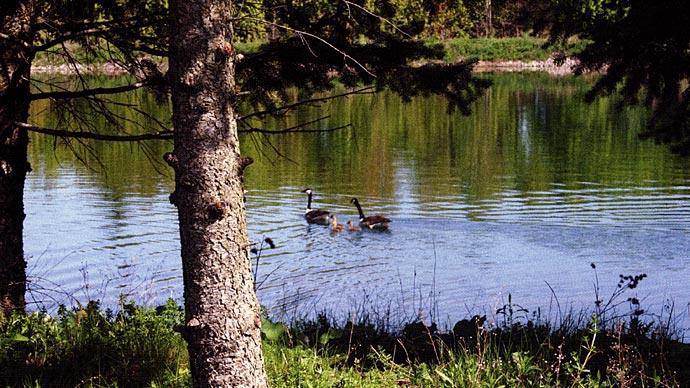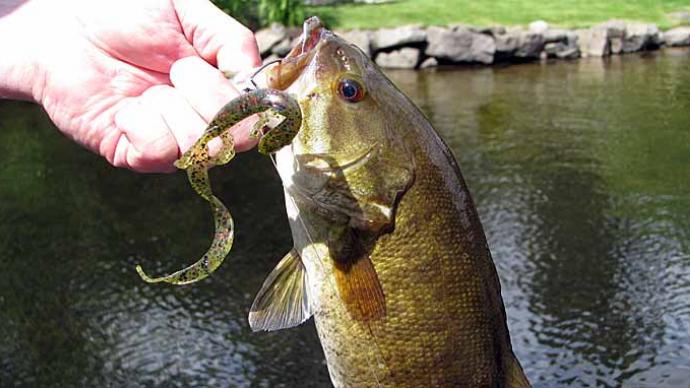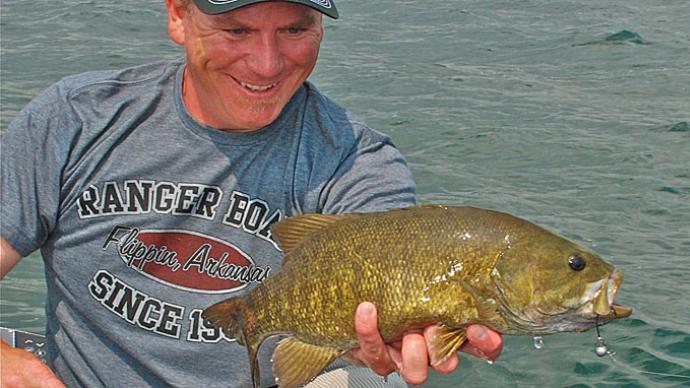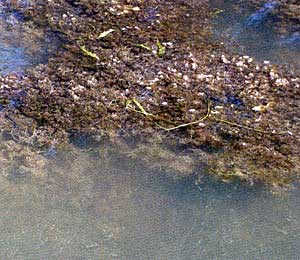
With the topic of politics dominating the nightly news these days, we decided to add our own idea of "talking points" for this article. Topic? Smallmouth bass!
• Smallmouth bass are pure fun! When it comes to fighting and jumping, this is a dandy fish! Adults and kids all enjoy them!
• In northern lakes and ponds, smallmouth bass reproduction and survival tends to be quite high. Selective harvest programs to reduce densities of young smallmouth bass will be needed to retain the quality of your population. On the other hand, a pond full of little smallmouth bass can provide a wonderful opportunity for kid's fishing because of high catch rates.
• In southern lakes and ponds, smallmouth bass year class production is much less consistent because reproduction is much less reliable. If low spawning occurs, occasional restocking with advanced sizes of adult or near-adult smallmouth bass might be in order. Pond Boss friend Aaron Matos has grown dandy smallmouths in his pond even in the heat of Arizona. A few other adventurous pondmeisters in Texas and Alabama are also seeing smallmouths survive in their small ponds.
• The best spawning substrates for smallmouths are a mixture of several sizes of gravel or stones that range from one-half to three inches in diameter. The gravel is often arranged in circular beds that are 24 to 40 inches in diameter. Male smallmouths prefer a large rock or solid structure near the nest site. The coarse nesting materials allow the eggs to drop among the crevices which helps protect the eggs and newly hatched yolk fry from being eaten by scavenging fish and crayfish.
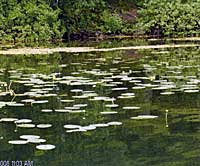
• Larger rocks and concrete pieces located along the shoreline splash zone to depths of three or four feet have proven to be good protection areas for the tiny smallies hatched that year. Rocky habitat also provides good colonization and feeding areas for invertebrates that serve as food for all sizes of smallmouths.
• Largemouth bass and smallmouth bass in ponds typically result in the smallies dying out. The largemouth bass seem to be better competitors. However, this does not happen overnight. In one South Dakota gravel pit, it actually took 10 years for the smallies to disappear. Plus, this scenario tends to lead to low densities of smallmouth bass, which allows them to grow to those nice 18 to 20 inch sizes. Restocking regularly with adult or near-adult smallies will help maintain the diversity of both bass species in your pond.
• The larger the body of water, the more likely the smallmouth and largemouth will cohabitate. Larger waters have more diverse habitats that allow smallmouth to find unique niche areas to better compete with the largemouths. Just consider large southern reservoirs. Often the largemouth bass are most abundant in the upper creeks and bays with woody structure. The smallies are down toward the lower end of the dam with the clearer water and rocky habitat, and the spotted bass, if present, are in between.

• Smallmouth bass are simply not as effective predators as largemouth bass, so do not consider them pond equivalents. If you have a three-acre pond with a 25 percent coverage of submergent aquatic plants during midsummer, a smallmouth bass/bluegill combination will not be a good idea. The smallmouths will not control the bluegills and they will overpopulate and stunt. Similarly, smallmouth bass will not control yellow perch in this type of habitat. When there is too much protective cover for the perch, the smallies will not control them. If you have a three-acre, northern pond with what looks like classic largemouth bass/bluegill habitat (25 to 30 percent vegetation coverage) and you REALLY want to produce big perch, go with the largemouth bass/yellow perch combination. (Willis experience).
• Bill Cody has found that in smaller ponds (1/4 to 1/2 acre), with very limited aquatic vegetation (10 percent or less), the smallies can indeed keep the yellow perch in check because they have easier access to the young perch. As a result, the smallies thin the numbers of small perch, and the remaining perch grow to sizes of interest to anglers.
• Redear sunfish and minnows are being used as a successful combination with smallmouths. Redears are not as prolific as bluegills, thus smallmouths can better control the limited recruitment of small redears. Small ponds can be supplementally stocked with minnow broodstock to serve as the primary prey. Smallmouth bass will be very piscivorous if they have an abundant and vulnerable prey fish supply. Small sizes of threadfin shad or small sunfish are common prey in southern ponds or reservoirs. Fathead minnows, golden shiners, or small yellow perch are good prey fish in northern ponds and lakes.
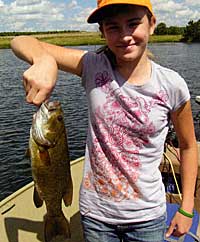
• Hybrid sunfish (usually bluegill male X female green sunfish) can be considered for use with smallmouth bass because the cross is skewed toward mostly males, and at least initially, reproduction is low. Lower reproduction by the hybrid sunfish makes it easier for the smallmouth bass to control them. Bill has used that combination with occasional pellet feeding in a small pond and it worked for quite a while, but after 12-15 years many of the offspring have more body characteristics of green sunfish and the amount of reproduction tends to increase. Again, a low amount of aquatic plant coverage helps smallies find the small hybrid sunfish.
• When prey fishes are not common, smallmouth bass will feed on aquatic insects, and of course, crayfish are always a common prey item wherever smallmouth bass thrive.
• Did you know that the "energy density" of crayfish is low? By that, we mean calories per unit weight of crayfish. Fishes tend to be much higher in energy density, with some oily fishes such as shad or smelt being very high. So, a smallmouth bass eating a certain same weight of fishes will grow faster than one eating the same weight of crayfish.
• In Bill's experience, smallmouth bass can be easier to train to eat fish pellets compared to largemouths. This is probably because smallies thrive better on primarily invertebrate food items compared to largemouths. A fish diet is reportedly not as critical for smallies; thus, they have a greater tendency to eat non-fish items that include fish pellets. Pellet feeding results in the smallies being less likely to become food limited and results in overall better growth rates and higher fish densities without the need for fertilizer stimulated or enhanced blooms.
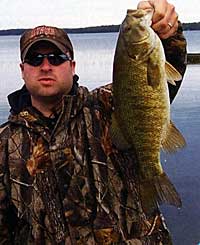
• One study found that smallmouth bass produced higher standing crops of bass per acre compared to the same ponds where largemouths had been raised previously (work by the Illinois Natural History Survey). Thus, if done correctly, more pounds of smallies can be raised per acre compared to largemouths. We think this reflects the ability of smallmouths to more efficiently use invertebrate food items. If a gravel pit in the Midwestern USA of average fertility can support 40 pounds/acre of largemouth bass, it might support 60 pounds/acre of smallmouth bass.
• There may be some differences in water quality preferences between smallmouth and largemouth bass. Neither of the authors is overly certain about this, and so we propose these ideas as a work in progress. We suspect that smallies do best with slightly higher quality water than largemouths. Probably the main water quality parameter is a need for higher average dissolved oxygen (DO) values across the year, which may be related to smallmouth bass evolving more in moving water compared to largemouth bass. Moving water tends to have higher DO than static ponds, especially if the pond is eutrophic (highly productive). In addition, smallies seem to prefer clearer water. Certainly when given a choice of seeking clearer or more colored water, they most often seek the clearer water. Smallies may be more inclined to be sight feeders (selecting, "picking" invertebrates) compared to largemouths. Experience suggests that largemouth bass tend to grow better in turbid (either green or brown) water compared to smallies. Turbid water resulting from algae blooms will also tend to have more frequent DO sags, whereas turbid water due to suspended silt will not experience as many DO sags because the suspended silt does not absorb DO at night. Poor success with smallmouth bass in the south may be more due to waters with eutrophic blooms than it is the higher temperatures. More information is needed to really understand these relationships with water quality. This is just our best assessment at this time.
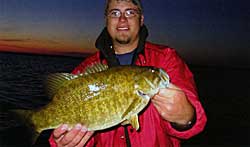
• Mr. Cody has seen well-fed fingerling smallmouths grow to a length of 10 to 12 inches long in one year. Densities were 50 smallies per acre and foods were minnows, shiners, crayfish, yellow perch, and redear sunfish.
• Smallmouths do have a tendency to become lure shy similar to largemouths. The smaller the pond and more often it is fished the more quickly the fish become "hook smart." Not fishing repeatedly with the same lure improves catch rates for bass over the long term. However, deciding to remove large numbers of young smallies that are highly used to lures can become problematic! If you anticipate needing a selective harvest program, start early!
• Culling abundant year class smallmouths and using slot limit harvest practices help grow larger smallies just as it does with largemouths. Keep your forage items abundant and your bass numbers wisely managed, and they will ensure your pond has lots of those dandy, tail walking, high leaping, beautifully marked smallmouth bass. Production of 18 to 20 inch smallmouth bass should be possible in essentially all ponds.
Remember that all of the above points are generalities and consider the basic needs of the smallmouth bass. There are always exceptions to all general rules. Smallmouths can be raised in many ponds across the USA if you follow some of these basic guidelines. As in all pond management and in fisheries biology—"it all depends." And, that's not just a talking point.
Reprinted with permission from Pond Boss Magazine

